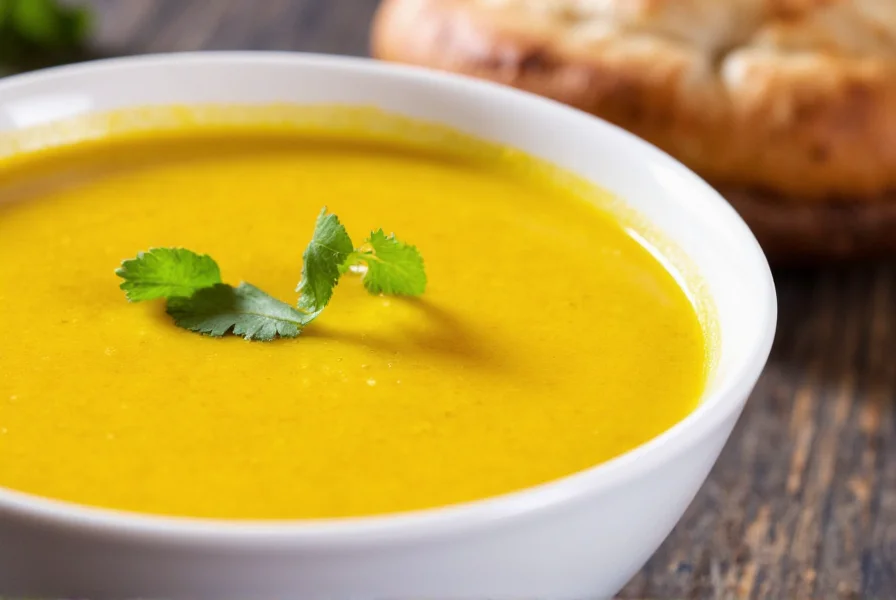The Essential Guide to Turmeric Soup: Flavor, Health, and Culinary Versatility
Turmeric soup represents one of the most accessible ways to incorporate curcumin—the active compound in turmeric—into your daily diet. Unlike supplements, soup preparation allows for strategic ingredient pairing that dramatically enhances turmeric's bioavailability and health impact. This comprehensive guide explores the science-backed benefits, optimal preparation methods, and diverse culinary applications of turmeric-based soups.Understanding Turmeric's Power in Soup Form
Turmeric (Curcuma longa) contains curcumin, a polyphenol with potent anti-inflammatory and antioxidant properties. However, curcumin has notoriously low bioavailability when consumed alone. Soup preparation solves this problem through three key mechanisms:- Fat solubility—Curcumin binds to fats, making coconut milk or olive oil additions essential
- Heat activation—Gentle cooking releases more curcuminoids from the rhizome
- Piperine synergy—Black pepper increases absorption by up to 2000%

Health Benefits Supported by Research
Multiple studies confirm turmeric soup's therapeutic potential. A 2023 meta-analysis published in Nutrients found that regular consumption of turmeric-containing foods significantly reduced inflammatory markers. The most pronounced effects occurred when participants consumed turmeric with fat and black pepper—exactly the conditions created in well-prepared turmeric soup.| Health Benefit | Scientific Support Level | Optimal Soup Preparation |
|---|---|---|
| Reduced inflammation | Strong (multiple RCTs) | Add 1/4 tsp black pepper + 1 tbsp coconut oil |
| Improved digestion | Moderate (observational) | Include ginger + lemon juice |
| Enhanced immunity | Preliminary (in vitro) | Combine with garlic + mushrooms |
| Pain relief | Moderate (clinical trials) | Use fresh turmeric root + slow simmer |
Mastering the Perfect Turmeric Soup Base
Creating an exceptional turmeric soup requires attention to ingredient quality and preparation technique. Follow these evidence-based guidelines:Ingredient Selection
- Turmeric: Fresh root provides 3x more curcumin than dried powder. Look for firm, smooth roots without wrinkles
- Fat source: Full-fat coconut milk outperforms dairy for curcumin absorption while maintaining vegan compatibility
- Acid component: Lemon or lime juice added at the end preserves volatile compounds
- Aromatic base: Onion, garlic, and ginger create flavor complexity while enhancing health benefits
Preparation Protocol
The sequence of ingredient addition significantly impacts both flavor development and nutrient preservation:- Sauté aromatics (onion, garlic, ginger) in coconut oil at medium heat
- Add fresh turmeric (grated) and black pepper, cooking for 2 minutes to activate compounds
- Pour in broth and bring to gentle simmer (avoid boiling to preserve nutrients)
- Add vegetables and protein sources, simmering until tender
- Remove from heat before adding citrus and fresh herbs

Regional Variations and Culinary Applications
Turmeric soup appears in diverse culinary traditions, each offering unique preparation methods and health benefits:- Indian Golden Milk Soup: Combines turmeric with ashwagandha and ghee for adaptogenic properties
- Caribbean Turmeric Chicken Soup: Features Scotch bonnet peppers for enhanced circulation benefits
- Thai Turmeric Coconut Soup: Incorporates lemongrass and kaffir lime for digestive support
- Middle Eastern Turmeric Lentil Soup: Pairs turmeric with cumin for improved iron absorption
Avoiding Common Preparation Mistakes
Many home cooks undermine turmeric soup's potential through preventable errors:- Overcooking turmeric: Boiling destroys up to 30% of curcuminoids—maintain gentle simmer below 160°F (71°C)
- Omitting black pepper: Without piperine, curcumin absorption remains minimal regardless of quantity used
- Using only dried turmeric: Fresh root contains turmerones with additional therapeutic properties
- Adding acid too early: Citrus compounds break down when cooked too long, reducing bioavailability
Storage and Reheating Best Practices
Proper storage maintains both flavor and nutritional value:- Cool soup completely before refrigerating (within 2 hours of cooking)
- Store in airtight glass containers to prevent flavor transfer
- Reheat gently over medium-low heat without boiling
- Add fresh lemon juice and herbs after reheating
- Consume within 4 days for maximum nutrient retention
Creating Therapeutic Turmeric Soup for Specific Needs
Tailor your turmeric soup preparation to address specific health concerns:- For joint pain: Add 1 tsp boswellia extract and increase black pepper to 1/2 tsp
- For digestive issues: Include fennel seeds and mint, using bone broth base
- For immune support: Incorporate shiitake mushrooms and extra garlic
- For cognitive health: Add walnuts and rosemary during final plating
Frequently Asked Questions
How much turmeric should I use in soup for health benefits?
For therapeutic effects, use 1-2 inches of fresh turmeric root (about 2-4 tablespoons grated) or 1-2 teaspoons of high-quality powder per serving. Research shows that consuming at least 500mg of curcumin daily provides measurable benefits, which translates to approximately 1.5 inches of fresh turmeric root per serving.
Can I make turmeric soup without coconut milk?
Yes, though coconut milk significantly enhances curcumin absorption. Suitable alternatives include olive oil (1-2 tablespoons per serving), avocado, or tahini. The critical factor is including a healthy fat source—without fat, curcumin absorption decreases by approximately 75%. For dairy-tolerant individuals, full-fat yogurt added after cooking works well.
Why does my turmeric soup stain the pot yellow?
Turmeric contains curcuminoids that act as natural dyes. To prevent stubborn staining, use stainless steel or enamel pots instead of aluminum. Immediately after cooking, fill the pot with hot water and a tablespoon of baking soda, letting it sit for 15 minutes before washing. Avoid using abrasive scrubbers which can create microscopic scratches where turmeric can embed.
How can I reduce the earthy taste of turmeric in soup?
Balancing turmeric's earthiness requires strategic flavor pairing. Add 1-2 teaspoons of maple syrup or honey to counter bitterness, incorporate citrus (lemon or lime juice), and include aromatic herbs like cilantro or mint. Combining turmeric with ginger (in a 2:1 ratio) creates a more complex flavor profile that masks excessive earthiness while enhancing health benefits.
Is store-bought turmeric soup as beneficial as homemade?
Most commercial turmeric soups lack the critical components for maximum benefit. They typically omit black pepper (reducing absorption), use insufficient turmeric quantities, and often contain preservatives that may counteract health benefits. If using store-bought versions, add fresh black pepper and a healthy fat source when reheating. For therapeutic effects, homemade preparation following evidence-based guidelines delivers significantly greater benefits.











 浙公网安备
33010002000092号
浙公网安备
33010002000092号 浙B2-20120091-4
浙B2-20120091-4